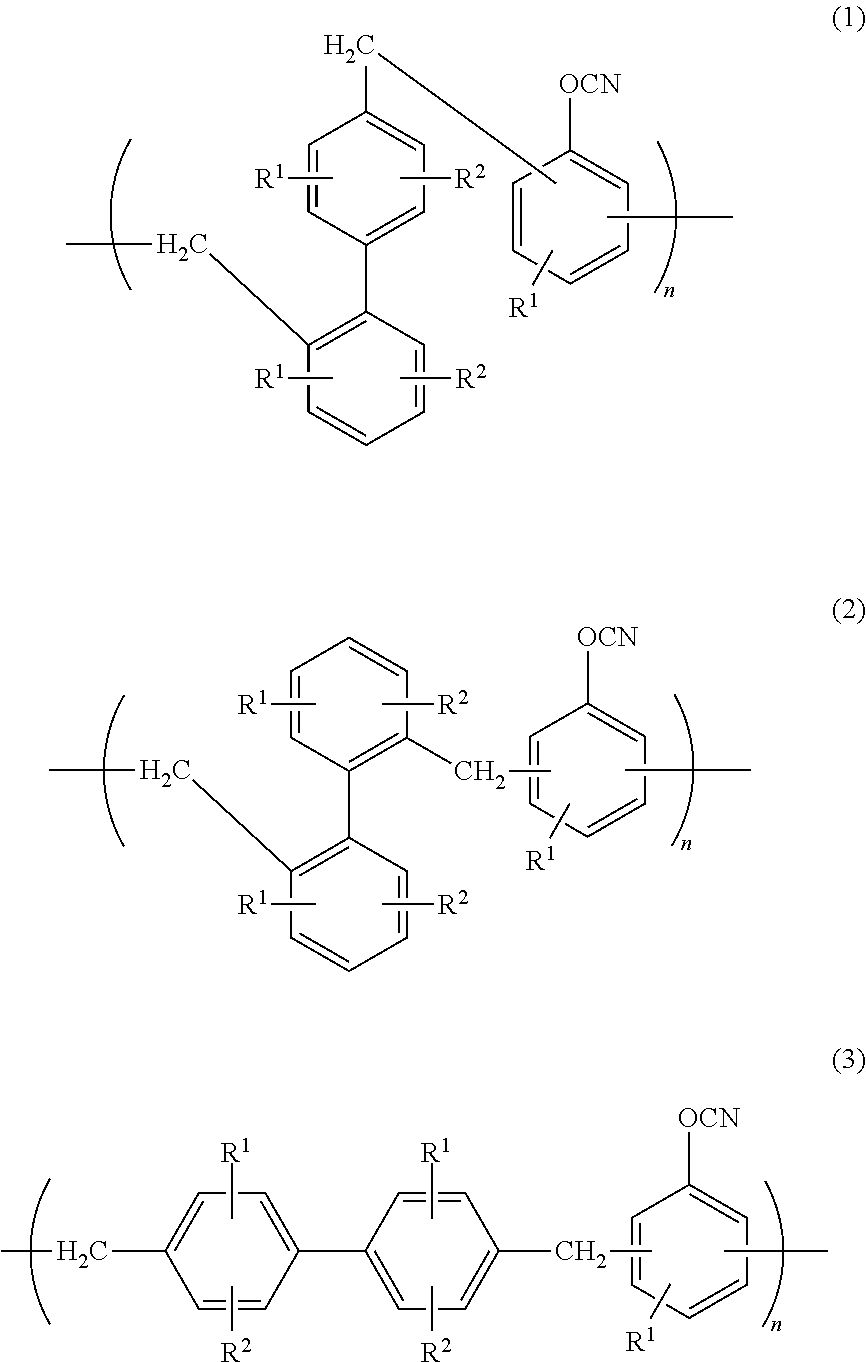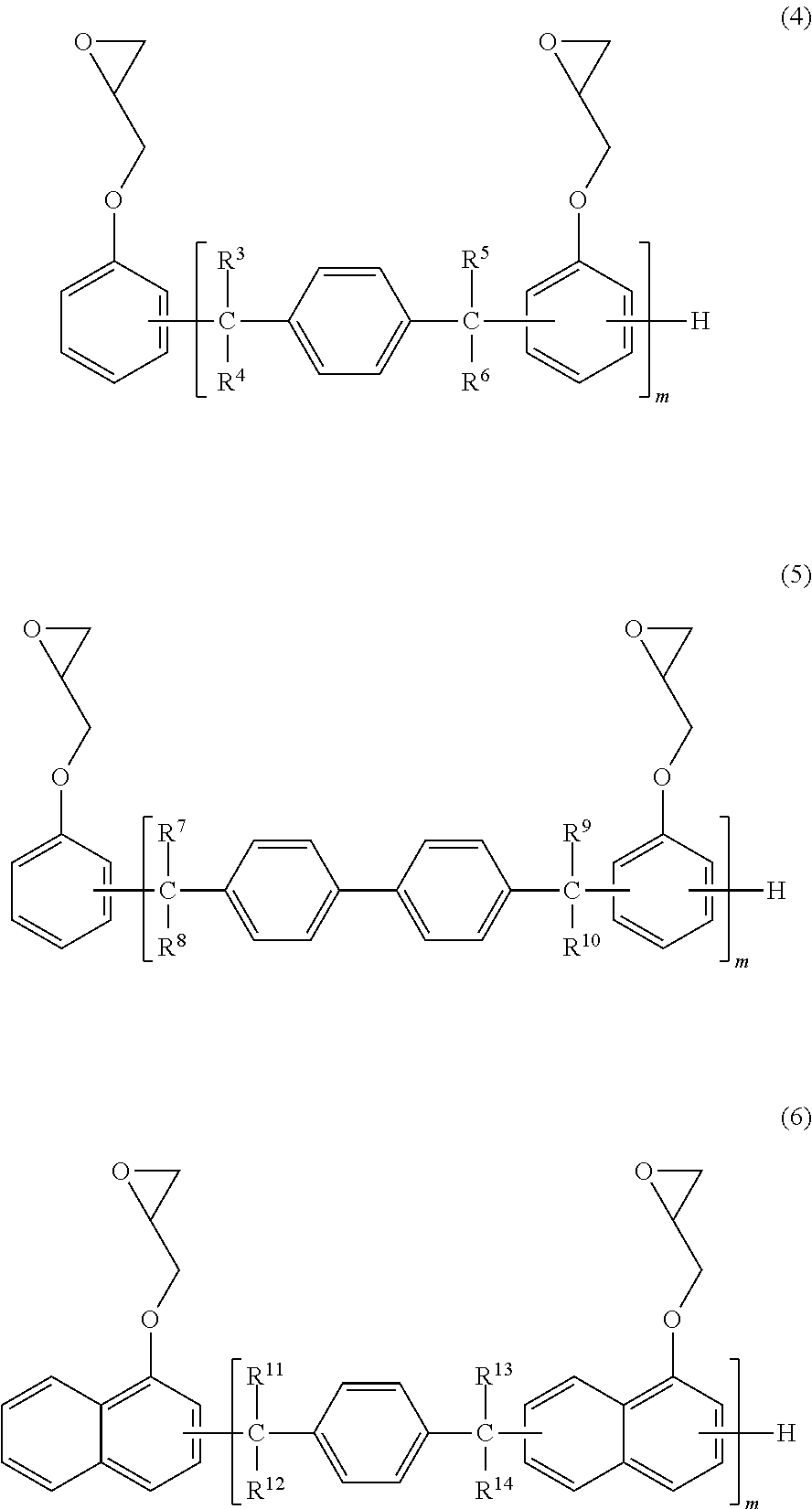Resin composition, prepreg, and laminate
a technology which is applied in the field of resin composition and prepreg, can solve the problems of difficult to cope with a demand for high heat resistance, and achieve the effects of excellent adhesive properties, excellent handling, and high solvent solubility
- Summary
- Abstract
- Description
- Claims
- Application Information
AI Technical Summary
Benefits of technology
Problems solved by technology
Method used
Image
Examples
synthetic example 1
Synthesis of Mixture of Biphenyl Aralkyl-Based Cyanate Ester Compound
[0072]A biphenyl aralkyl-based phenol compound (MEH-7852, OH group equivalent: 183 g / eq, manufactured by Meiwa Chemical Co., Ltd.) was used as a raw material. The biphenyl aralkyl-based phenol compound was analyzed according to 1H-NMR measurement. As a result, the biphenyl aralkyl-based phenol compound contained components represented by the following formulae (10) to (12) at rates shown in Table 1-A.
[0073]In 475 mL of chloroform, 1.22 mol (in terms of OH group) of the biphenyl aralkyl-based phenol compound and 1.82 mol of triethylamine were dissolved to obtain a solution 1. The solution 1 was dropwise added to 600 g of a 2.43 mol cyan chloride / methylene chloride solution at −10° C., taking 1.5 hours to obtain a solution 2. The solution 2 was stirred for 30 minutes, and a mixed solution of 0.49 mol triethylamine and methylene chloride (50 g) was then dropwise added to the solution 2 to obtain a solution 3. The solu...
synthetic example 2
Synthesis of 4,4′-Biphenyl Aralkyl-Based Cyanate Ester Compound
[0076]In 900 mL of 3-methyltetrahydrofuran, 1.1 mol (in terms of OH group) of 4,4′-biphenyl aralkyl-based phenol resin (KAYAHARDGPH-65, OH group equivalent: 204 g / eq, manufactured by Nippon Kayaku Co., Ltd.) and 1.6 mol of triethylamine were dissolved to obtain a solution 1-2. The solution 1-2 was dropwise added to 2500 g of a 2.2 mol cyan chloride / methylene chloride solution at −10° C., taking 1.5 hours to obtain a solution 2-2. The solution 2-2 was stirred for 30 minutes, and a mixed solution of 0.4 mol triethylamine and methylene chloride (100 g) was then dropwise added to the solution 2-2 to obtain a solution 3-2. The solution 3-2 was further stirred for 30 minutes to complete the reaction. The hydrochloride of triethylamine was filtered from the solution 3-2 to obtain a filtrate. The obtained filtrate was washed with 1000 mL of 0.1 N hydrochloric acid and then with 1000 mL of water, and this washing was repeated fou...
example 1
[0078]Fifty parts by mass of the mixture of biphenyl aralkyl-based cyanate ester compounds synthesized in Synthetic Example 1, 50 parts by mass of a biphenyl aralkyl-based epoxy resin (NC3000-H manufactured by Nippon Kayaku Co., Ltd.), 0.04 part by mass of zinc octylate (manufactured by Nihon Kagaku Sangyo Co., Ltd.), and 100 parts by mass of synthetic silica (SC-2050MR manufactured by Admatechs Co., Ltd., average particle diameter: 0.8 μm) were mixed to obtain a resin composition. Methyl ethyl ketone was added to the resin composition to obtain a varnish. The varnish was further diluted with methyl ethyl ketone. The diluted varnish was impregnated into and coated on an E-glass cloth (thickness: 0.1 mm). The impregnated and coated E-glass cloth was dried under heat at 160° C. for 4 minutes, to obtain prepregs having a resin content of 48% by mass. Next, four prepregs obtained above were stacked and 18 μm-thick electrolytic copper foils were placed on the upper and lower surfaces of ...
PUM
| Property | Measurement | Unit |
|---|---|---|
| thickness | aaaaa | aaaaa |
| thickness | aaaaa | aaaaa |
| thickness | aaaaa | aaaaa |
Abstract
Description
Claims
Application Information
 Login to View More
Login to View More - R&D
- Intellectual Property
- Life Sciences
- Materials
- Tech Scout
- Unparalleled Data Quality
- Higher Quality Content
- 60% Fewer Hallucinations
Browse by: Latest US Patents, China's latest patents, Technical Efficacy Thesaurus, Application Domain, Technology Topic, Popular Technical Reports.
© 2025 PatSnap. All rights reserved.Legal|Privacy policy|Modern Slavery Act Transparency Statement|Sitemap|About US| Contact US: help@patsnap.com



